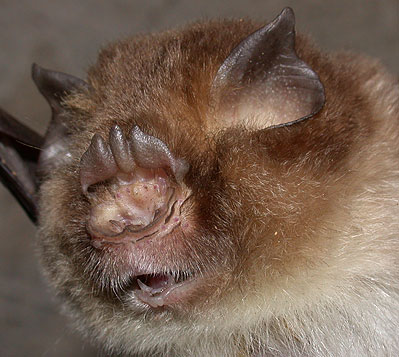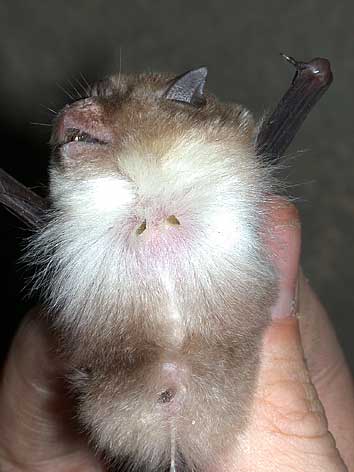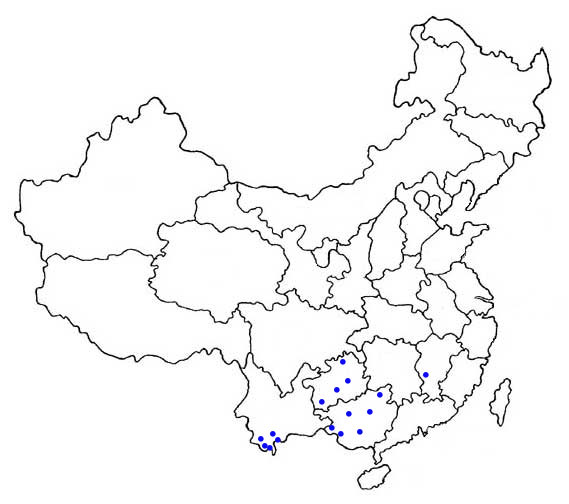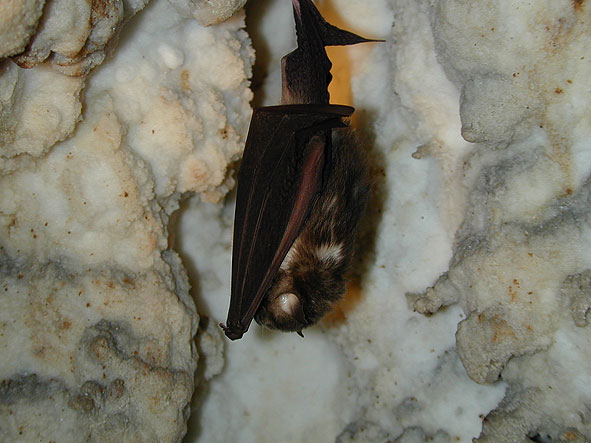Stoliczka's Trident Bat
Aselliscus stoliczkanus
Morphological description Life history Distribution Habitat Roost sites and roosting patterns Emergence and flight pattern Foraging behaviour Echolocation calls Status and protection


Morphological Description
· Dorsal fur is brown or reddish. Ventral fur is grey or white-grey.
· Juveniles are darker than adults.
· We caught one male in Yunnan, 2003, with forearm length 45.6mm and weight 6.9g.
· There are glands on the chest (lower right image).
· The upper margin of the anterior noseleaf is divided into 3 points, the middle one separated from the lateral ones by deep grooves (see lower photo above). This is diagnostic.
Sequence divergence values between A. stoliczkanus sampled in Guizhou and Sichuan vs. Yunnan provinces was relatively high (5-6%). However these values were considerably lower than the divergence between A. stoliczkanus and A. tricuspidatus . In combination with the absence of echolocation call frequency differences among Chinese populations, the sequence divergence estimates suggest that Chinese A. stoliczkanus may represent geographic races, rather than distinct species (Li et al. 2007).
Life history
· Little known
Distribution
The distribution in China is shown by the dots on the map (as given by Zhang et al. 1997).

Habitat
· Little known.
Roost sites and roosting behaviour
· Roosts found in caves in Yunnan, often sharing roost with other species.
Emergence and flight pattern
·Aselliscus flies at low speeds and is very small-bodied, roosting in caves and foraging in cluttered microhabitats (Feng 2001). Their low wing loading (as in most rhinolophid and hipposiderid species) lends flexibility when hunting for prey in a complicated environment.
Foraging behaviour
· The diet of A. stoliczkanus is mainly composed of lepidopterans, beetles, and hemipteran insects. Lepidoptera were the most abundant food items in the samples (79% of the diet in volume), followed by Coleoptera (15%), Hemiptera (7%) and Odonata (<1%) (Li et al. 2007). Feng (2001) recorded 43% Lepidoptera, 29% Coleoptera, 14% Diptera and small quantities of Trichoptera and Hymenoptera at the same site in Guizhou. Nabhitabhata (1986) found moth remains in the stomachs of all 3 bats examined in Thailand , and Diptera in one stomach.
Echolocation calls
The echolocation call is a relatively short constant frequency signal with a brief frequency-modulated tail.
To listen to the call of the Stoliczka's trident bat, click here
Size of sound file: 204 kb
Average values for echolocation calls, as given by Li et al. 2007, are listed below:
Call duration: 5.4 ms; Constant frequency at 120.3 kHz on average in Sichuan and Guizhou, sweep at end terminating at 104.5 kHz. CF frequency of two bats in Yunnan 118.4 kHz and 119.3 kHz (Li et al. 2007).
Status and protection
There is no estimation of population size for China.
· Trident bats are at LR/lc, assessed by the Red List of Threatened Species (IUCN, 2006) and not listed in the Law of the People's Republic of China on the Protection of Wildlife in 1989.
· Caves and old buildings should be protected as their habitats.
